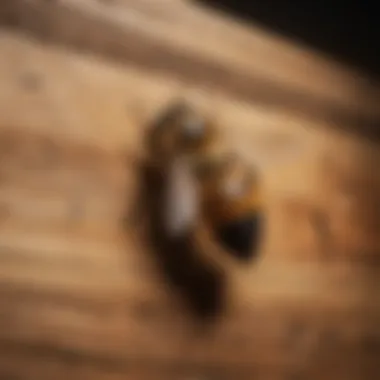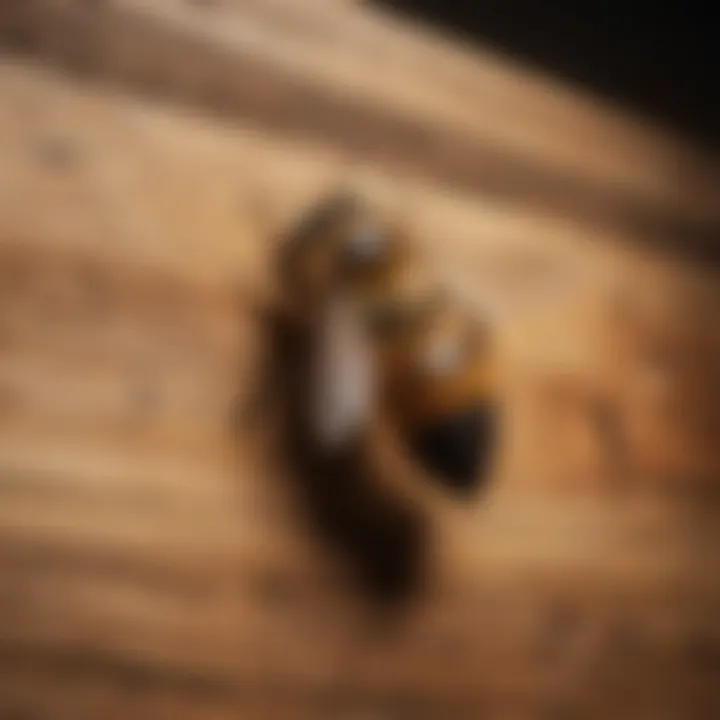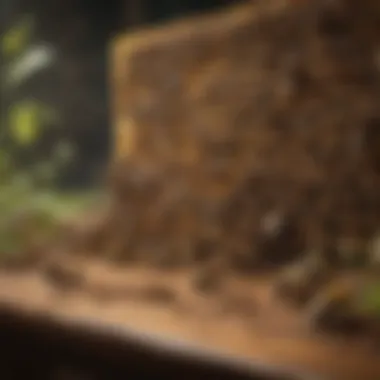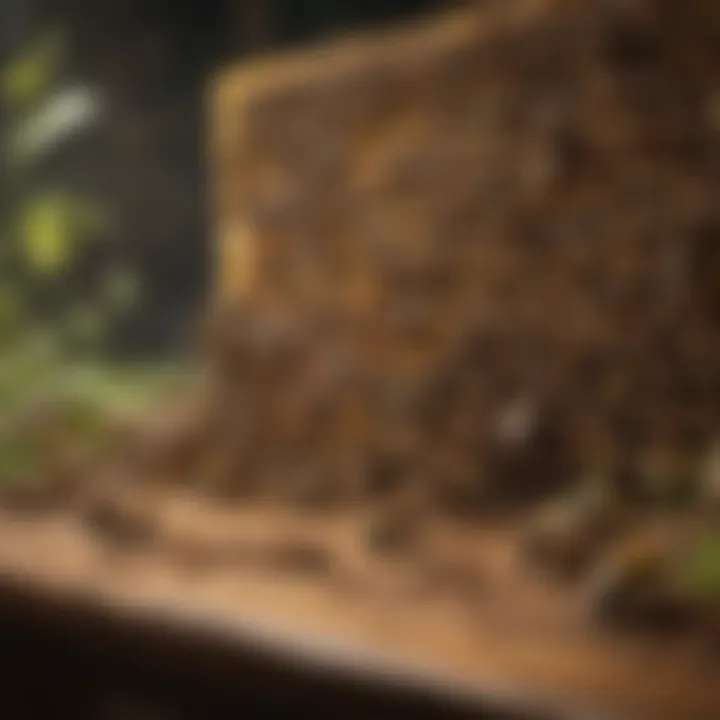Bees and Wood: A Complex Ecological Connection


Intro
The relationship between bees and wood might not seem significant at first glance. Bees are predominantly known for their essential role in pollination and honey production. However, a closer examination reveals a fascinating aspect of their behavior: wood consumption. This peculiar interaction opens up a new dimension in bee ecology. By exploring how certain species of bees utilize wood, we can gain insights into their dietary habits and the ecological roles they play.
Understanding this niche behavior among bees challenges conventional views on their feeding patterns. It also prompts further inquiry into the biological mechanisms at play. This knowledge is vital for researchers and environmentalists alike, as it can influence conservation strategies and enhance our overall understanding of ecosystems.
Below, we will delve into the aspects that define this intriguing relationship, highlighting the key points and significance of wood-eating behaviors among bees.
Preamble to Bees and Their Diverse Diets
The relationship between bees and their dietary habits is intricate and key to understanding their ecological roles. While many people recognize bees primarily as pollinators, their diets encompass much more than just nectar and pollen. This section will explore the physiological mechanisms and primary food sources for bees. Knowing these elements is essential not just for researching bees but also for appreciating the complexities of their interactions with various ecosystems.
Understanding Bee Physiology
To comprehend how bees consume and process food, we must first examine their physiology. Bees possess specialized mouthparts designed for different feeding methods. The proboscis, for example, allows them to extract nectar from flowers. Alongside this, their digestive systems are adapted to break down various nutrients effectively.
Other body features also contribute to how bees digest food. They have microbial populations in their guts that can help in the breakdown of complex materials. This symbiosis with microbes enables bees to maximize nutrient absorption from their diets.
Primary Food Sources of Bees
Bees primarily rely on two key food sources: nectar and pollen.
- Nectar: This sugary liquid serves as the main energy source. It varies in composition depending on the plant source, affecting bees’ nutrition.
- Pollen: Rich in proteins and fats, pollen is essential for brood development. Different floral sources provide varying nutrient profiles, influencing bee health and productivity.
While nectar and pollen are crucial, some bees have been observed consuming alternative materials such as sap or, in rare cases, wood. Understanding these diverse food sources complements the overall picture of bee ecology, prompting more questions about how they interact with their environment.
The Rarity of Wood-Eating Behavior
The behavior of wood consumption among bees is an intriguing phenomenon. While many people recognize bees primarily for their role in pollination, wood-eating represents an exceptional adaptation that some species possess. This section aims to highlight the importance of understanding wood consumption in the context of bee ecology.
The rarity of this behavior is notable. It presents unique physiological and ecological adaptations. Examining the species that consume wood is essential for grasping the underlying mechanisms that allow these bees to thrive in environments where other food sources may be scarce. Knowing which bees are engaged in this behavior can lead to insights about their roles within their ecosystems and how they can contribute to overall biodiversity.
Examining Species That Consume Wood
There are only a few species of bees that exhibit wood-eating behavior. Notably, Xylocopa species, commonly known as carpenter bees, show a keen interest in wood as a food source. These bees are not simply drilling into wood to create habitats. They are also feeding on the wood, which provides them with various nutrients.
The rarity of this behavior among bees hints at its specialized nature. Most bees predominantly rely on nectar and pollen from flowers. In contrast, wood-consuming species have evolved to exploit a resource that is not typically accessible to their more nectar-oriented relatives. This niche adaptation allows them to survive in specific ecological contexts, particularly in areas where floral resources fluctuate.
Adaptations for Wood Consumption
Bees that consume wood possess several key adaptations that enable them to thrive on this unconventional diet.
- Digestive System Modifications: Their gastrointestinal tracts are uniquely designed to break down wood fibers. These modifications allow for the extraction of essential nutrients from lignocellulose, which is primarily resistant to digestion in many other organisms.
- Microbial Symbiosis: Many wood-eating bees harbor symbiotic microorganisms in their guts. These microbes facilitate the degradation of wood materials, transforming them into digestible compounds.
- Behavioral Adaptations: Wood-consuming bees demonstrate specific foraging techniques. They often use their mandibles to scrape wood, allowing them to access the inner layers where nutrients are concentrated. This behavior often requires greater effort and energy than typical nectar foraging, indicating a high level of specialization.
Understanding these adaptations is crucial to appreciate the ecological significance of wood-eating bees. Their unique feeding habits can influence the milling processes in ecosystems, affecting nutrient cycling and contributing to soil health. Further research into these peculiarities may uncover additional roles that wood-consuming bees play within their environments.
Nutritional Benefits of Wood Consumption for Bees


In the ongoing exploration of bee ecosystems, the nutritional advantages of wood consumption emerge as a pivotal aspect. While bees primarily rely on nectar and pollen, certain species exhibit unique behavioral patterns that include wood consumption. This phenomenon offers insignts into their survival strategies, revealing how such dietary choices enhance their overall nutrition. Understanding the nutritional benefits is essential not only for comprehending bee health but also for recognizing how it affects broader ecological systems.
Chemical Composition of Wood
Wood, while often perceived as an inert material, harbors a range of chemical constituents that can be beneficial for bees. The composition of wood includes cellulose, lignin, hemicellulose, and various phenolic compounds. Each of these elements contributes to the nutritional profile that some bee species exploit.
- Cellulose: As a major component of plant cell walls, cellulose provides structural support. For certain bees, the breakdown of cellulose becomes crucial as it can release sugars that serve as an energy source.
- Lignin: In small amounts, lignin can offer some antioxidant properties. Bees may gain certain benefits from its presence, aiding in their overall health.
- Hemicellulose: This is a group of polysaccharides that are easier to break down than cellulose. It may provide additional energy resources for wood-consuming bees.
- Phenolic Compounds: Although these are more common in the bark, they also show potential health benefits due to their antimicrobial properties. This can be essential in maintaining a balanced gut flora within bees, therefore affecting their digestion and overall vitality.
Enzymatic Processes Involved in Wood Digestion
To harness the nutrients from wood, certain bee species have developed specialized enzymatic capabilities. These enzymes are crucial in degrading the wooden material into simpler, digestible forms.
- Cellulases: These enzymes play a fundamental role in breaking down cellulose into glucose. This is vital as glucose can directly serve as an energy source for bees.
- Lignases: These are involved in the degradation of lignin, allowing bees to access the sugars locked within the wood structure.
- Hemicellulases: Targeting hemicellulose, these enzymes facilitate the breakdown of this polysaccharide, contributing to the energy pool available to bees.
Through these enzymatic actions, bees can extract necessary nutrients from wood, demonstrating their adaptability and resourcefulness in challenging environments.
"Understanding how bees utilize wood goes beyond simply observing their behavior; it shows how intricately they engage with their environment."
In summary, the nutritional benefits of wood consumption for bees are multifaceted, revealing a complex interaction between their diet and their ecological role. The chemical composition of wood, along with the specific enzymatic processes that enable its digestion, highlight a remarkable adaptation that enhances the survivability of wood-eating bee species.
Ecological Role of Wood-Eating Bees
The role that wood-eating bees play within their ecosystems is often misunderstood or entirely overlooked. While many people view bees primarily as pollinators, those that consume wood contribute significantly to ecological balance and health. These specialized interactions with wood help maintain various processes that are vital to ecosystem functioning. Wood-eating bees can enhance nutrient cycling and support plant health indirectly, demonstrating their value beyond simple pollen collection.
Impact on Ecosystem Dynamics
Wood-eating bees influence ecosystem dynamics through their unique feeding habits. By breaking down wood, they participate in the breakdown of organic matter. This action not only provides nutrients back into the soil but also fosters rich habitats for various microorganisms. These microorganisms are crucial for soil health, promoting a biodiverse environment. As bees consume wood, they expose the inner layers of the plant to the air, which can facilitate the colonization by fungi and bacteria that further decompose the material.
Additionally, wood-eating bees can interconnect with other species. For instance, the areas where these bees nest or forage may attract other insects. This increased presence of different organisms creates a complex web of relationships in the ecosystem. It enhances biodiversity and leads to a more resilient environment, which is better able to withstand changes and challenges.
"Every species plays an important role in its ecosystem; neglecting even the lesser-known behaviors could lead to missing deeper ecological connections."
Facilitating Decomposition Processes
One of the most critical contributions of wood-eating bees is their facilitation of decomposition processes. Decomposition is essential for nutrient cycling; without it, ecosystems could not thrive. Wood, being a complex organic material, requires dedicated organisms for its breakdown. This is where wood-eating bees come into play.
These bees have specific adaptations that allow them to digest and process wood. Through their activities, wood is broken down into simpler components. As they consume wood, they release waste that is rich in nutrients, thus enriching the soil.
The interaction between bees, wood, and other decomposers creates a system in which nutrients are efficiently recycled. Moreover, these ecological interactions help regulate overall plant growth. The decomposition process supported by wood-eating bees ultimately benefits neighboring plants, leading to healthier woodlands and landscapes.
In summation, the ecological role of wood-eating bees extends well beyond what is commonly understood. Their contributions ensure ecological resilience and sustainability, affirming the importance of protecting these unique species and their habitats.
Comparative Analysis with Other Wood-Consuming Species
Understanding the relationship between bees and wood consumption requires a broader perspective that includes other wood-consuming species. This comparative analysis is crucial for multiple reasons. First, it sheds light on unique adaptations and evolutionary traits that specific insects have developed to digest wood. Looking beyond bees provides a clearer picture of how different organisms interact with wood substrates, showcasing ecological diversity.
Wood Eating Insects Beyond Bees


Numerous insects are known to consume wood, each employing different methods to break down tough fibers. Termites are among the most notable wood-eating insects. They are equipped with symbiotic microorganisms in their guts that enable them to digest cellulose efficiently, a significant component of wood. These insects play an essential role in breaking down dead trees and recycling nutrients into the soil.
Another example is the wood-boring beetle, such as the Hylotrupes bajulus. This species not only consumes wood but also creates tunnels that can weaken the structural integrity of trees. The adaptations in their digestive systems allow these beetles to thrive in environments rich in woody material.
Furthermore, certain species of ants, like Camponotus spp., have been observed to chew wood for nesting material. They create elaborate nests within dead wood, which offers protection from predators while also promoting the decomposition of the wood they consume. These insects exemplify various ecological roles, underlining the importance of wood in many life cycles beyond that of bees.
"The ability to consume wood offers various species a unique ecological niche, essential for their survival and ecosystem functionality."
Contrasts in Digestive Mechanisms
When comparing wood-consuming species, the differences in their digestive mechanisms become evident. Bees, for instance, have evolved in a way that allows them to occasionally consume wood, primarily in specific environmental contexts. However, their digestive process is not adapted to efficiently break down wood like that of termites or wood-boring beetles. The adaptation in these other species includes specialized enzymes produced by symbiotic organisms. Bees lack such a complex digestive system and typically do not derive significant nutrients from wood.
This contrast emphasizes the specialization within the animal kingdom. Termites possess unique protozoa that allow them to extract nourishment from cellulose, whereas bees generally benefit from more traditional pollen and nectar sources.
In summary, comparative analysis helps clarify the adaptations that allow various insects to thrive on wood as a food source. Each species showcases different methodologies to utilize this resource, contributing to a rich web of ecological interactions. Understanding these differences is essential for appreciating the role of bees within this complex ecosystem.
Challenges Faced by Wood-Eating Bees
The relationship between bees and wood is as fascinating as it is complex. However, wood-eating bees face numerous challenges that threaten their survival and ecological role. This section will analyze three fundamental challenges: habitat loss, competition with other organisms, and the impact of climate change on resource availability. Each of these factors plays a critical role in the future of these unique bees.
Habitat Loss and Its Implications
Habitat loss is one of the most pressing issues for wood-eating bees. Urbanization, agricultural expansion, and deforestation severely diminish the availability of wood sources that these bees rely on for their dietary needs. As forests and other wooded areas are cleared, the natural habitats of these bees are disrupted. This can result in a decline in bee populations, as their primary food sources are destroyed or made inaccessible.
Furthermore, habitat destruction leads to fragmentation. This interruption in habitat continuity can isolate bee populations, which decreases genetic diversity. Lower genetic diversity can hamper adaptability, making it more difficult for these bees to survive in changing environments. The disruption of ecological balances may also result in a decrease in the provision of essential resources for these bees, compounding the threat to their survival.
Competition with Other Organisms
The competition for resources is intense among various species within an ecosystem. Wood-eating bees often find themselves competing with other insects that also consume wood, such as termites or beetles. These organisms can be highly efficient in breaking down wooden substrates, which can limit the availability of resources for wood-eating bees.
The interaction between these species can alter the dynamics of food availability and feeding strategies. When competition is fierce, it may force wood-eating bees to expend more energy searching for food or adapting their feeding habits, affecting their overall health and longevity. Moreover, the presence of invasive species can exacerbate this problem, as they can quickly dominate and disrupt local ecosystems, further straining the resources available to native wood-eating bee populations.
Impact of Climate Change on Availability of Resources
Climate change is another significant threat to wood-eating bees. Rising temperatures and altered precipitation patterns can impact the growth and health of trees, which are crucial sources of food for these bees. Changes in seasonal patterns may lead to mismatches between the life cycles of bees and the availability of suitable wood for feeding.
Furthermore, as environments change, the distribution of flora that supports wood-eating behavior may shift, leading to a decline in available resources. Extreme weather events, such as storms or droughts, can also cause direct damage to the tree populations that these bees rely on, further threatening their survival.
Conservation Strategies for Wood-Eating Bees
Conservation strategies for wood-eating bees are crucial in maintaining their populations and the ecological roles they fulfill. These strategies focus on habitat preservation, restoration efforts, and enhancing biodiversity. Bees that consume wood play unique roles in their ecosystems, such as aiding in decomposition and nutrient cycling. Addressing challenges like habitat loss and climate change is vital for sustaining these species. The implementation of targeted conservation efforts can lead to positive outcomes for both bees and the habitats they depend on.
Promoting Habitat Restoration
Habitat restoration is a key aspect of conserving wood-eating bees. Restoration involves returning degraded ecosystems to their natural state, providing bees with the resources they need to thrive. This includes planting native trees and shrubs that are part of their diet. For instance, creating areas with fallen branches and decaying wood can mimic natural habitats. These structures provide food and nesting sites for the bees.
Moreover, engaging local communities in restoration projects raises awareness about the importance of wood-eating bees. Workshops on how to maintain healthy forests and gardens can aid in this mission. By fostering a sense of stewardship among residents, we can enhance local biodiversity, creating environments that support both bees and other wildlife.


Enhancing Biodiversity in Fabaceae and Myrtaceae
Enhancing biodiversity within the Fabaceae and Myrtaceae families is another important strategy for supporting wood-eating bees. These plant families are known for their varied species that often provide essential resources for many bee species, including wood-eaters.
Increased biodiversity leads to a more resilient ecosystem. This means that as some species thrive or decline, others can fill their ecological roles. Encouraging a diverse planting of Fabaceae and Myrtaceae in gardens and urban settings is beneficial.
Planting trees and shrubs from these families supports a wider range of bees. Additionally, creating mixed-species plantings ensures a continuous supply of food sources throughout the seasons. This can attract bees and provide them with the necessary nutrients for survival and reproduction.
In summary, conservation strategies focusing on habitat restoration and enhancing biodiversity are vital for the survival of wood-eating bees. Without these efforts, we risk losing these important species and the ecological balance they maintain.
The Future of Wood-Eating Bees
Examining the future of wood-eating bees is vital for understanding both their ecological role and the broader implications for biodiversity. As environments evolve, these species face unique challenges and potential opportunities. Research efforts are increasingly focusing on wood-eating bees due to their contributions to ecosystem health and stability. These species play a niche role in breaking down wood, which aids in nutrient cycling within forest ecosystems.
Current Research Trends and Findings
Recent research on wood-eating bees has expanded significantly. Scientists are delving into the genetic and physiological adaptations that allow certain bee species to consume wood. Studies have shown that some bees host symbiotic microorganisms that assist in breaking down complex cellulose structures found in wood. This relationship not only enhances the bees' ability to derive nutrients but also opens avenues for biotechnological applications. Furthermore, field studies are ongoing to document the spatial distribution of wood-eating bees and their habitat preferences. This data plays a crucial role in monitoring ecological changes and developing conservation strategies.
Highlights of current research trends include:
- The exploration of microbial symbiosis in wood digestion.
- The mapping of wood-eating bee habitats and their ecological interactions.
- Assessment of wood consumption impacts on forest health and diversity.
"Understanding the adaptations of wood-eating bees can lead to insights into their potential resilience in changing environments."
Potential Advancements in Bee Conservation
Advancements in conservation efforts for wood-eating bees are imperative, especially given the pressures they face from habitat loss and climate change. Innovative conservation practices are being developed that focus on preserving the habitats these bees rely on. This includes restoring degraded forests and creating buffers around wood sources. Additionally, fostering relationships with local communities can enhance awareness and support for bee conservation initiatives.
Potential advancements include:
- Research-Driven Habitat Restoration: Tailored restoration efforts that are informed by ecological research can enhance the existing habitats of wood-eating bees.
- Integration of Technology: Using technology like drones for habitat mapping and monitoring can provide real-time data on bee populations.
- Community Engagement Programs: Educating homeowners and gardeners about the significance of wood-eating bees can promote biodiversity in urban ecosystems.
By investing in these areas, we can foster a more robust understanding and response to the needs of wood-eating bee populations, ensuring their survival and ecological function in a changing world.
Finale: Reevaluating Bee Ecologies
The relationship between bees and wood consumption offers a unique perspective on bee ecologies. Understanding this connection is crucial for several reasons. First, it challenges the traditional perception of bees solely as pollinators. Many people are unaware that certain species of bees have adapted to consuming wood. This behavior provides insights into their ecological roles and the nutritional strategies they employ.
Second, the ecological significance of wood-eating behavior extends beyond the individual species. It impacts the broader ecosystem dynamics. Bees that consume wood may influence decomposition processes and nutrient cycling in their environments. These interactions can, in turn, affect plant health and biodiversity, highlighting the interconnectedness of various species within an ecosystem.
Finally, recognizing the diversity of bee diets allows for a more nuanced approach to conservation efforts. As we encounter challenges such as habitat loss and climate change, it is crucial to understand all dietary sources for bees. This comprehensive view can lead to more effective strategies for protecting these important pollinators and their habitats.
Summary of Findings
This exploration of the relationship between bees and wood consumption reveals several key points:
- Diversity of Diets: Some bee species exhibit wood-eating behaviors. Their physiology allows them to digest and derive nutrients from wood, showcasing adaptability.
- Ecological Roles: Wood-eating bees play significant roles in their ecosystems. They participate in decomposition and nutrient cycling, impacting overall biodiversity.
- Challenges: Habitat loss, competition, and climate change pose significant threats. Understanding how these factors affect wood-eating bee populations is essential for their conservation.
Implications for Future Research
Future research should focus on expanding our understanding of wood-eating bees. Specific areas worth exploring include:
- Nutritional Analysis: More studies are needed to analyze the specific nutrients that wood provides to these bees. Understanding the biochemical processes involved could reveal new insights into their adaptation.
- Ecosystem Impact: Investigating how wood-eating behavior affects various ecosystem functions can strengthen our knowledge of bee ecology. Studies that focus on the interaction between bees and their environment can inform conservation practices.
- Conservation Strategies: Developing targeted conservation strategies based on research findings can help protect both bee species and wood substrates. This effort should prioritize habitats that support diverse diets, including wood-rich areas.
In summary, reevaluating bee ecologies with respect to wood consumption enhances our understanding of bees, their roles, and the necessary conservation actions required to safeguard their future.















